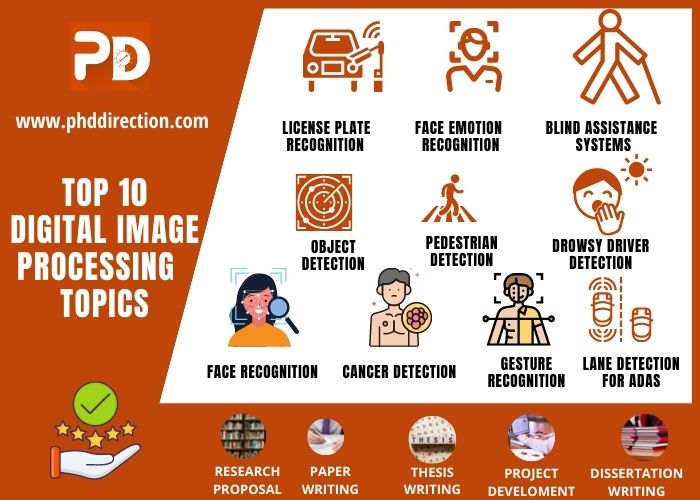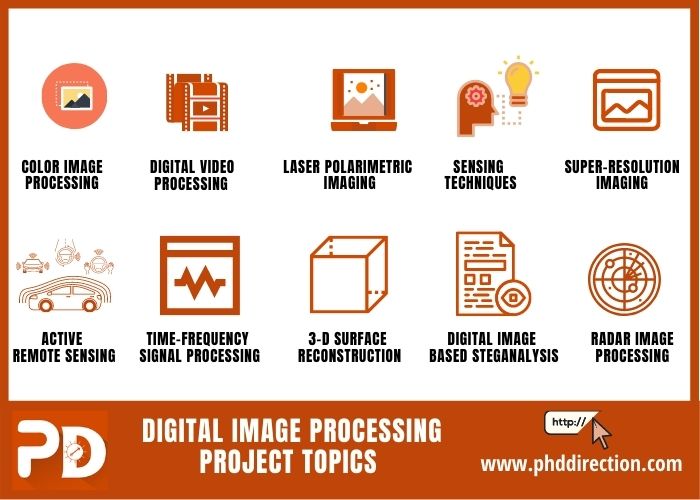Top 10 Digital Image Processing Project Topics
We guide research scholars in choosing novel digital image processing project topics. What is meant by digital image processing? Digital Image Processing is a method of handling images to get different insights into the digital image. It has a set of technologies to analyze the image in multiple aspects for better human / machine image interpretation. To be clearer, it is used to improve the actual quality of the image or to abstract the essential features from the entire picture is achieved through digital image processing projects.
This page is about the new upcoming Digital Image Processing Project Topics for scholars who wish to create a masterpiece in their research career!!!
Generally, the digital image is represented in the form of pixels which are arranged in array format. The dimension of the rectangular array gives the size of the image (MxN), where M denotes the column and N denotes the row. Further, x and y coordinates are used to signify the single-pixel position of an image. At the same time, the x value increases from left to right, and the y value increases from top to bottom in the coordinate representation of the image. When you get into the DIP research field, you need to know the following key terminologies.

Important Digital Image Processing Terminologies
- Stereo Vision and Super Resolution
- Multi-Spectral Remote Sensing and Imaging
- Digital Photography and Imaging
- Acoustic Imaging and Holographic Imaging
- Computer Vision and Graphics
- Image Manipulation and Retrieval
- Quality Enrichment in Volumetric Imaging
- Color Imaging and Bio-Medical Imaging
- Pattern Recognition and Analysis
- Imaging Software Tools, Technologies and Languages
- Image Acquisition and Compression Techniques
- Mathematical Morphological Image Segmentation
Image Processing Algorithms
In general, image processing techniques/methods are used to perform certain actions over the input images, and according to that, the desired information is extracted in it. For that, input is an image, and the result is an improved/expected image associated with their task. It is essential to find that the algorithms for image processing play a crucial role in current real-time applications. Various algorithms are used for various purposes as follows,
- Digital Image Detection
- Image Reconstruction
- Image Restoration
- Image Enhancement
- Image Quality Estimation
- Spectral Image Estimation
- Image Data Compression
For the above image processing tasks, algorithms are customized for the number of training and testing samples and also can be used for real-time/online processing. Till now, filtering techniques are used for image processing and enhancement, and their main functions are as follows,
- Brightness Correction
- Contrast Enhancement
- Resolution and Noise Level of Image
- Contouring and Image Sharpening
- Blurring, Edge Detection and Embossing
Some of the commonly used techniques for image processing can be classified into the following,
- Medium Level Image Processing Techniques – Binarization and Compression
- Higher Level Image Processing Techniques – Image Segmentation
- Low-Level Image Processing Techniques – Noise Elimination and Color Contrast Enhancement
- Recognition and Detection Image Processing Algorithms – Semantic Analysis
Next, let’s see about some of the traditional image processing algorithms for your information. Our research team will guide in handpicking apt solutions for research problems. If there is a need, we are also ready to design own hybrid algorithms and techniques for sorting out complicated model.
Types of Digital Image Processing Algorithms
- Feature detection algorithm: Detect the specified feature based on the feature points in an image. And also, it is classified into the following types. These algorithms are used to find the edges, local features, gradient information, etc.
- Hough Transform Algorithm
- Canny Edge Detector Algorithm
- Scale-Invariant Feature Transform (SIFT) Algorithm
- Generalized Hough Transform Algorithm
- Speeded Up Robust Features (SURF) Algorithm
- Marr–Hildreth Algorithm
- Contrast Enhancement algorithm: It sharpens the image by minimizing the noise, for example, edge or contrast borders. Further, it is classified into the following algorithms for color enhancement.
- Connected-component labeling algorithm: Identify and classify the disconnected areas
- Histogram equalization algorithm: Enhance the contrast of image by utilizing the histogram
- Adaptive histogram equalization algorithm: Perform slight alteration in contrast for the equalization of the histogram
- Dithering and half-toning algorithm: Improves the resolution of the image by appropriate Dithering and half-toning techniques.
- Error Diffusion Algorithm
- Ordered Dithering Algorithm
- Floyd–Steinberg Dithering Algorithm
- Riemersma Dithering Algorithm
- Richardson–Lucy deconvolution algorithm: It is also known as a deblurring algorithm, which removes the misrepresentation of the image to recover the original image
- Seam carving algorithm: Differentiate the edge based on the image background information and also known as content-aware image resizing algorithm
- Segmentation algorithm: Partition the digital image into two or more pieces based on different constraints to understand the image better in all the angles
- Region Growing Algorithm
- GrowCut Algorithm
- Watershed Transformation Algorithm
- Random Walker Algorithm
- Elser difference-map algorithm: It is a search based algorithm primarily used for X-Ray diffraction microscopy to solve the general constraint satisfaction problems
- Blind deconvolution algorithm: It is similar to Richardson–Lucy deconvolution to reconstruct the sharp point of blur image. In other words, it’s the process of deblurring the image.
Nowadays, various industries are also utilizing digital image processing by developing customizing procedures to satisfy their requirements. It may be achieved either from scratch or hybrid algorithmic functions. As a result, it is clear that image processing is revolutionary developed in many information technology sectors and applications.

Digital Image Processing Techniques
- Low pass filters (mean, weighted mean, median, mode)
- In order to smooth the image, substitutes neighbor median / common value in the place of the actual pixel value. Whereas it is performed in the case of weak edge sharpness and blur image effect.
- Geometric operation
- Eliminate the distortion in an image by scaling, wrapping, translation, and rotation process
- Color Enhancement/Transformation
- Differentiate the in-depth image content to figure out the original hidden data or to convert the color image into a gray-scale image
- Segmentation
- Breaking up of image into multiple forms based on certain constraints. For instance: foreground, background
- Contrast enhancement
- Enhance the image display through pixel-based threshold operation
- Averaging
- Reduce the noise in an image by the average of diverse quality multiple images
- High pass filters
- Sharpening the image by improving the pixel value in the edge
- Fast Fourier Transform
- Extract the specific feature for removal of noise in an image
- Arithmetic operation
- Perform arithmetic operations (add, sub, divide and multiply) to identify the variation in between the images
Beyond this, this field will give you numerous Digital Image Processing Project Topics for current and upcoming scholars. Below, we have mentioned some research ideas that help you to classify analysis, represent and display the images or particular characteristics of an image.
Latest 11 Interesting Digital Image Processing Project Topics
- Acoustic and Color Image Processing
- Digital Video and Signal Processing
- Multi-spectral and Laser Polarimetric Imaging
- Image Processing and Sensing Techniques
- Super-resolution Imaging and Applications
- Passive and Active Remote Sensing
- Time-Frequency Signal Processing and Analysis
- 3-D Surface Reconstruction using Remote Sensed Image
- Digital Image based Steganalysis and Steganography
- Radar Image Processing for Remote Sensing Applications
- Adaptive Clustering Algorithms for Image processing
Moreover, if you want to know more about Digital Image Processing Project Topics for your research, then communicate with our team. We will give detailed information on current trends, future developments, and real-time challenges in the research grounds of Digital Image Processing.
Why Work With Us ?
Member Book
Publisher Research Ethics Business Ethics Valid
References Explanations Paper Publication
9 Big Reasons to Select Us
Senior Research Member
Our Editor-in-Chief has Website Ownership who control and deliver all aspects of PhD Direction to scholars and students and also keep the look to fully manage all our clients.
Research Experience
Our world-class certified experts have 18+years of experience in Research & Development programs (Industrial Research) who absolutely immersed as many scholars as possible in developing strong PhD research projects.
Journal Member
We associated with 200+reputed SCI and SCOPUS indexed journals (SJR ranking) for getting research work to be published in standard journals (Your first-choice journal).
Book Publisher
PhDdirection.com is world’s largest book publishing platform that predominantly work subject-wise categories for scholars/students to assist their books writing and takes out into the University Library.
Research Ethics
Our researchers provide required research ethics such as Confidentiality & Privacy, Novelty (valuable research), Plagiarism-Free, and Timely Delivery. Our customers have freedom to examine their current specific research activities.
Business Ethics
Our organization take into consideration of customer satisfaction, online, offline support and professional works deliver since these are the actual inspiring business factors.
Valid References
Solid works delivering by young qualified global research team. "References" is the key to evaluating works easier because we carefully assess scholars findings.
Explanations
Detailed Videos, Readme files, Screenshots are provided for all research projects. We provide Teamviewer support and other online channels for project explanation.
Paper Publication
Worthy journal publication is our main thing like IEEE, ACM, Springer, IET, Elsevier, etc. We substantially reduces scholars burden in publication side. We carry scholars from initial submission to final acceptance.